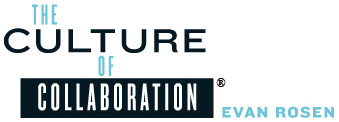INTRODUCTION - The Culture of CollaborationOur collective culture, particularly in the United States, perpetuates
the Myth of the Single Cowboy. This is the notion that one self-sufficient,
rugged individual can achieve smashing success without help from
anybody. Consider our preoccupation with celebrity. We turn athletes,
chefs, politicians, surgeons, television hosts, entrepreneurs,
corporate leaders and many others into stars. This tendency creates
the impression that we accomplish great feats by ourselves. Many organizations reinforce the Myth of the Single Cowboy by embracing a star culture. Such cultures reward people for competing with colleagues. The primary motivator often becomes fear rather than value creation. In these environments, getting ahead requires hoarding ideas and information. Why share knowledge with competitors? In such cultures, opportunities to maximize time, talent and tools die on the vine. The Culture of Collaboration is about changing business models and organizational DNA. Collaborative organizations promote sharing over hoarding, trust over fear and community over isolation. With these and other values, we can more easily replace linear, serial business models with concurrent, real-time approaches that are infinitely more compelling. Rather than designing parts individually and assembling them into a product, we can design parts, products and manufacturing processes all at the same time. In service industries, it’s a similar story. We can include people from multiple functions in developing services and processes. They can participate simultaneously, instead of passing instructions through levels and functions for others to implement. The Culture of Collaboration also enables companies to participate in developing, assembling, delivering, and supporting products and services throughout the world. By creating a universe of globally-distributed business partners, organizations can operate as a single enterprise round-the-clock. They may utilize collaboration tools and common processes and systems to reduce barriers including geography and time zones. These partnering companies form the global collaborative enterprise, which we will discuss in chapter 10. With the expectation of closing the distance gap, companies with operations in multiple countries may adopt the right processes, systems, strategies and tools to enable collaboration. In many cases, however, their efforts come up short. Collaboration may occur, but only sporadically. Something is missing. Managers may blame the lack of collaboration on technological shortcomings. And, in fact, technology plays a role. In most cases, however, the overwhelming reason why collaboration eludes organizations involves culture. This book’s fundamental premise is that maximizing time, talent and tools to create value requires the Culture of Collaboration.
Let’s begin by examining the sweeping changes that are redefining work, business models, and organizations.
|
DESERIALIZING TIME, TALENT AND TOOLS
TO CREATE VALUE IN THE LOCAL AND GLOBAL ECONOMY |
|
